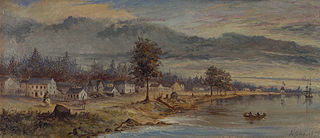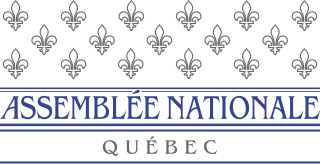
The Province of Canada was a British colony in British North America from 1841 to 1867. Its formation reflected recommendations made by John Lambton, 1st Earl of Durham, in the Report on the Affairs of British North America following the Rebellions of 1837–1838.

The Parliament of Canada is the federal legislature of Canada, seated at Parliament Hill in Ottawa, and is composed of three parts: the King, the Senate, and the House of Commons. By constitutional convention, the House of Commons is dominant, with the Senate rarely opposing its will. The Senate reviews legislation from a less partisan standpoint and may initiate certain bills. The monarch or his representative, normally the governor general, provides royal assent to make bills into law.

York was a town and second capital of the colony of Upper Canada. It is the predecessor to the old city of Toronto (1834–1998). It was established in 1793 by Lieutenant-Governor John Graves Simcoe as a "temporary" location for the capital of Upper Canada, while he made plans to build a capital near today's London, Ontario. Simcoe renamed the location York after Prince Frederick, Duke of York and Albany, George III's second son. Simcoe gave up his plan to build a capital at London, and York became the permanent capital of Upper Canada on February 1, 1796. That year Simcoe returned to Britain and was temporarily replaced by Peter Russell.

The Family Compact was a small closed group of men who exercised most of the political, economic and judicial power in Upper Canada from the 1810s to the 1840s. It was the Upper Canadian equivalent of the Château Clique in Lower Canada. It was noted for its conservatism and opposition to democracy.

Upper Canada College (UCC) is an independent day and boarding school for boys in Toronto, Ontario, operating under the International Baccalaureate program. The college is widely described as Canada's most prestigious preparatory school, and has produced many notable graduates. With around 1,200 students, UCC is highly selective, accepting approximately 15% of all applicants in 2019. The school has a financial aid program which currently awards more than $5 million annually to Canadian citizens.

The Province of Quebec was a colony in British North America which comprised the former French colony of Canada. It was established by the Kingdom of Great Britain in 1763, following the conquest of New France by British forces during the Seven Years' War. As part of the Treaty of Paris, France gave up its claim to the colony; it instead negotiated to keep the small profitable island of Guadeloupe.

The National Assembly of Quebec is the legislative body of the province of Quebec in Canada. Legislators are called MNAs. The King in Right of Quebec, represented by the lieutenant governor of Quebec, and the National Assembly compose the Legislature of Quebec, which operates in a fashion similar to those of other Westminster-style parliamentary systems. The assembly has 125 members elected first past the post from single-member districts.

The Legislative Assembly of Ontario is the legislative chamber of the Canadian province of Ontario. Its elected members are known as Members of Provincial Parliament (MPPs). Bills passed by the Legislative Assembly are given royal assent by the lieutenant governor of Ontario to become law. Together, the Legislative Assembly and Lieutenant Governor make up the unicameral Legislature of Ontario or Parliament of Ontario. The assembly meets at the Ontario Legislative Building at Queen's Park in the provincial capital of Toronto.

John Hamilton Gray, was a politician in the Province of New Brunswick, Canada, a jurist, and one of the Fathers of Confederation. He should not be confused with John Hamilton Gray, a Prince Edward Island politician in the same era.

James Cox Aikins, was a prominent Canadian politician in the 19th century. He twice served as a cabinet minister in the government of John A. Macdonald, and was the fourth Lieutenant Governor of Manitoba from 1882 to 1888.
Annamarie Castrilli is a former politician, lawyer, educator and rights advocate in Ontario, Canada.

The Speaker of the Legislative Assembly of Ontario is the presiding officer of the Legislative Assembly of Ontario.

The government of Ontario is the body responsible for the administration of the Canadian province of Ontario. A constitutional monarchy, the Crown—represented in the province by the lieutenant governor—is the corporation sole, assuming distinct roles: the executive, as the Crown-in-Council; the legislature, as the Crown-in-Parliament; and the courts, as the Crown-on-the-Bench. The functions of the government are exercised on behalf of three institutions—the Executive Council; the Provincial Parliament ; and the judiciary, respectively. Its powers and structure are partly set out in the Constitution Act, 1867.

Nelson Parliament was Speaker of the Legislature of Ontario from 1920 to 1923. He was first elected as a Liberal MLA for Prince Edward in the 1914 provincial election and served in the assembly until 1923.

The First Parliament of the Province of Canada was summoned in 1841, following the union of Upper Canada and Lower Canada as the Province of Canada on February 10, 1841. The Parliament continued until dissolution in late 1844.

The Ontario Youth Parliament (OYP), formerly the Ontario Older Boys' Parliament, is one of a number of provincial youth model parliaments across Canada. Each year, the organization holds a four-day debate conference on Family Day weekend for youth ages 14 to 21 from Ontario, Canada. The organization has roots within the United Church of Canada dating back to 1907. The first session of the Older Boys' Parliament met in the Ontario Legislative Building at Queen's Park in Toronto in January 1925. As a result, the OYP, as successor to the Older Boys' Parliament, is one of the oldest youth parliaments in Canada. Gordon Lapp of Brighton served as the first Premier.

The 41st Legislative Assembly of Ontario was a legislature of the government of the province of Ontario, Canada. The membership was set by the 2014 Ontario general election. The 41st parliament of Ontario was dissolved on May 8, 2018.

The 42nd Legislative Assembly of Ontario was a legislature of the province of Ontario, Canada. The membership was set by the 2018 Ontario general election and sat for two sessions until it was dissolved on May 3, 2022 in advance of the 2022 Ontario general election.
Prince Edward was an electoral district of the Legislative Assembly of the Parliament of the Province of Canada, in Canada West. It was created in 1841, upon the establishment of the Province of Canada by the union of Upper Canada and Lower Canada. Prince Edward was represented by one member in the Legislative Assembly. It was abolished in 1867, upon the creation of Canada and the province of Ontario.















